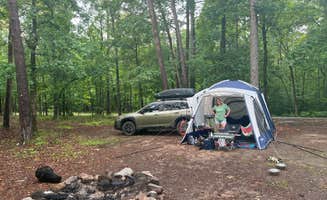Dispersed camping near Alabaster, Alabama encompasses several primitive camping areas within a 30-mile radius. Many of these sites sit at elevations between 300-500 feet, with summer temperatures often exceeding 90°F and high humidity levels. Winter camping offers more comfortable conditions with daytime temperatures averaging 50-60°F, though occasional freezing nights occur between December and February.
What to do
Fishing opportunities: Blue Creek Public Use Area offers direct access to waterways where anglers can catch bass and catfish. The boat ramp provides convenient water entry, and camping spots along the bluff provide excellent fishing vantage points. One visitor notes, "I have camped here several times, alway relaxing and restful. Has a latrine, no water or electric. Has boat ramp and camping areas are near pacer park roads."
Stargazing sessions: Hollins Hunting Camp features open areas with minimal light pollution, creating ideal conditions for night sky observation. A camper mentioned, "Open to sky (took awesome star pics here)," highlighting the unobstructed views. The pine-covered areas provide natural clearings where telescopes can be set up.
Hiking excursions: Plan day hikes on nearby trails that connect to camping areas. Many trails range from 1-5 miles in length with moderate elevation changes. Camping near trailheads allows for early morning starts before summer heat intensifies. Pack extra water as most trails have no water sources.
What campers like
Privacy levels: Despite some boat ramp traffic, Blue Creek Public Use Area offers relatively secluded camping spots. A recent camper shared, "Fun spot. Very easy to get to. Nice big site felt very private only had 2 or 3 cars come by but everything was very low key." The area has multiple distinct camping zones that provide separation between groups.
Natural cooling: The riverside location at Blue Creek creates natural air movement even during hot summer months. One visitor observed, "Large area overlooking the river that gives you a slight breeze for 85 degrees in mid June." This natural ventilation makes summer camping more comfortable than inland sites.
Open camping layout: Hollins Hunting Camp provides flexible camping arrangements without designated sites. A camper explained, "No marked sites, just pull in and find a spot. I got in around 8 and there were only a couple people here, lots of space and easy to find a private spot." This flexibility allows groups to create their own camping configurations.
What you should know
Water planning: Most dispersed camping areas near Alabaster lack potable water sources. Bring 1-2 gallons per person per day, especially during summer months. At Weogufka State Forest Backcountry Site 1, water access requires additional effort as noted by one camper: "There is not any water right here so you will either have to carry it in or hike down to one of the nearby streams to fill up."
Road conditions: Access roads to camping areas vary significantly in quality. Some sites have paved approaches while others require navigating rough terrain. For Blue Creek, a camper mentioned, "About a handful of spots, all with ample room and privacy. Rough road there, but overall easy access and nice view."
Signage limitations: Navigation to some camping areas can be challenging due to minimal directional signs. At Hollins Hunting Camp, one visitor reported it "Lacked good signage on the last turn." Download offline maps before arrival and note key landmarks for navigation.
Tips for camping with families
Historical features: The platform at Weogufka State Forest provides educational opportunities about local history. One visitor described, "This site appears to have a platform that was built to set up a tent on where an old building used to stand. The fireplace is the only part that is still in place which would actually be kind of nice to use on a cold night."
Bug preparation: Pack insect repellent for wooded camping areas, especially during warmer months. One camper at Hollins Hunting Camp noted, "Hardly any bugs, no amenities," though experiences vary by season. Citronella candles and permethrin-treated clothing provide additional protection.
Space considerations: Select camping areas with ample room for family activities. Blue Creek accommodates larger groups with varied terrain. A visitor observed, "Big enough for several overlanding rigs or tents. There is also a large spot just a little further down. It's more private, but view is not as nice."
Tips from RVers
Site selection for trailers: Small travel trailers can access some dispersed sites, but turnaround space may be limited. At Hollins Hunting Camp, a camper advised, "Overlanders (w/rtt) will be the most happy. Small camper trailers could probably make it too. Just be mindful of turn around spots." Scout potential sites before committing to a specific location.
Leveling challenges: Bring adequate leveling blocks as many dispersed sites feature uneven terrain. Most areas lack designated parking pads, requiring creative positioning to achieve level setup. Extra stabilization equipment helps compensate for natural ground contours.
Waste management: With limited facilities at most dispersed camping locations, RVers must be self-contained. Blue Creek provides a latrine, but most other areas require carrying out all waste. Plan for 3-5 days of water and waste storage capacity when visiting these primitive areas.


